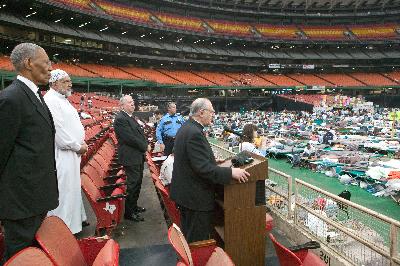If the title sounds like the beginning of an old joke, then it follows a week of the cruelest possible jokes. I suppose some people will find it in poorest taste that a couple of dozen revellers decided to go ahead with Southern Decadence, the “gay Mardi Gras” event, but at least that sounds like New Orleans. Better to laugh than cry, sometimes at least. I suspect the two have blended in the full, coupled with mania, desperation, and perhaps madness.
We beseech thee to hear us, good Lord.
That it may please thee to minister unto such as are any ways afflicted or distressed in mind, body, or estate, to comfort and relieve them according, to their need, giving them patience under their trials, and a happy issue out of all their afflictions.
Just a little something from the litany of a 1894 Universalist prayerbook. I think it’s time to start doing a bit more theology and Christian nurturance, peppered with the occasional comment about the disaster and some helpful tips about preparing against future disaster. (I still think a few thousand pressuring letters to the President would prove useful.)

Yesterday, in the Astrodome, there was held some kind of religious service. I know the civil authorities at the Astrodome (which is whom, I wonder) have to be everything to everyone but I’ve been in enough interfaith events to know they’re a bit forced and contrived even in the best and most agreeable circumstances. And given these circumstances, I can’t help but think that it must have seemed awkward and paradoxically both the right thing to do, and perfectly useless.
The photos are from FEMA (public domain), and the one above had the caption
Houston, TX., September 4, 2005 — Archbishop Joseph A. Fiorenza (at podium), Rev. Bill Lawson (left to right), Sheik Mustafa Mahmoud and Rabi [sic] David Rosen deliver Sunday services to Hurricane Katrina evacuees housed in the Red Cross shelter in the Houston Astrodome. FEMA photo/Andrea Booher
What would you do if you were in such a circumstance: either behind podium — a bad visual, I must add — a relief worker on the floor, or one of the thousands brought there? What spiritual gifts and graces would you bring to bear? James at Peregrinato begins this thought.

Houston, TX., September 9, [sic] 2005 — Alezhanjla and Gary Mutin, Hurricane Katrina evacuees, listen to Sunday services given by Rev. Bill Lawson, Sheik Mustafa Mahmoud, Archbishop Joseph A. Fiorenz (left to right),and Rabi David Rosen (at podium) in the Red Cross shelter in the Houston Astrodome. FEMA photo/Andrea Booher



